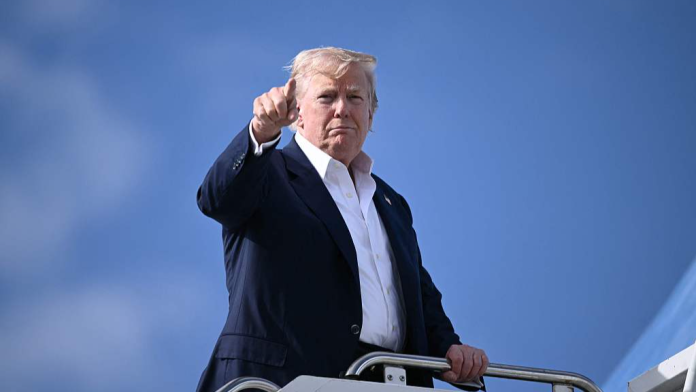The head of the White House announced on Tuesday that he was reducing the 50-day deadline he had previously set for achieving a truce between Russia and Ukraine to ten days. If the negotiations fail, Donald Trump plans to impose import tariffs, sanctions or “something else.”
At the same time, the American leader admitted that he was not sure about the effectiveness of the restrictions.
Reaffirming the deadline for a peaceful settlement of the conflict in Ukraine, Trump tried to demonstrate the seriousness of his intentions and hint that “Putin’s time is running out.”
There are several factors behind the sharp reduction in time allocated for negotiations:
- The situation in Ukraine. The US fears a strengthening of Russia’s position on the front line (for example, possible control over Pokrovsk) and is seeking to resolve the situation through negotiations.
- Pressure on China and India. The US is signalling to Russia’s partners the price of further co-operation with Moscow.
In addition, against the backdrop of the announced trade agreement between the US and the EU and parallel “concessions” for European products, Trump is seeking to put pressure not only on Russia, but also on Asian countries.
Trump’s proposals
However, the paradox of the situation is that Trump himself is limiting his own options by his own decision. If Moscow does not respond to the ultimatum, and so far the Kremlin remains calm, then Trump will have to act again. For now, the following possible scenarios can be identified:
- Compromise. Trump, while maintaining his tough and radical rhetoric, introduces a limited package of sanctions. This variant is highly likely. It is no coincidence that he sought complete freedom in the adoption of anti-Russian measures. These could be some less sensitive restrictions that will be presented as “destructive” and “unprecedented.” Sanctions against the banking sector. Possibly new technological sanctions.
- Escapist. On August 8, Trump may declare the conflict in its current phase to be irresolvable and announce the withdrawal or minimisation of the US peacekeeping mission.
Probability: medium. This would mean Washington distancing itself further from the Ukrainian case.
- Indefinite. Trump may announce tough decisions but use his favourite tactic of “suspending” their immediate implementation.
Probability: medium. Sanctions will be announced on August 8 but will come into force three months later, for example, and during this time Moscow will receive signals about a possible review of the decisions.
- Demonstrative. Trump may sell as a victory, for example, the signing of a joint memorandum in which Moscow and Kyiv will confirm their commitment to a peaceful settlement.
Probability: low. Of course, it is unlikely that the parties will take such a step, as neither Russia nor Ukraine is interested in it. However, Washington may still put pressure on the parties to achieve at least symbolic, rather than substantive, successes.
- Ultimatum. Trump actually introduces all the promised measures: sanctions against banks, the energy sector, secondary sanctions against Russia’s partners.
Probability: extremely low. The exhaustion of available tools makes further pressure impossible. In addition, Trump is not having an easy time in the trade war he initiated against the whole world. Further escalation with China and India could exacerbate the situation.
What about fresh US tariffs
For now, most experts consider the actual introduction of 100% tariffs unlikely.
Economists note that trade between Russia and the US is already close to zero, so the main risks fall on Russia’s partner countries. China and India are the main importers of Russian oil, accounting for 80–85% of exports. The American market is crucial for their economies, but it is extremely difficult for them to replace Russian energy resources.
Circumventing sanctions. China has already developed schemes to circumvent Western restrictions (for example, with Iranian oil). India, although more cautious, may publicly agree but will keep its business with Russia “in the shadows.”
Potential effect. The introduction of such harsh tariffs would almost certainly plunge the global economy into crisis: oil prices would rise, and shortages and inflation would appear in the US and the EU.
Trump’s statement indicates his willingness to go all the way. He even said that he is no longer very interested in meeting with Russian President Vladimir Putin. Trump’s confidence is bolstered by the recent trade deal with the EU and, possibly, behind-the-scenes agreements with Saudi Arabia and India.
However, Moscow is mostly taking Trump’s threats in stride and staying calm. Officials and experts say that these “deadlines” and threats are meant for the American political market, not to really change Russia’s political course.
THE ARTICLE IS THE AUTHOR’S SPECULATION AND DOES NOT CLAIM TO BE TRUE. ALL INFORMATION IS TAKEN FROM OPEN SOURCES. THE AUTHOR DOES NOT IMPOSE ANY SUBJECTIVE CONCLUSIONS.
Sigmund Huber for Head-Post.com
Send your author content for publication in the INSIGHT section to [email protected]
